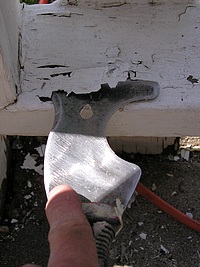 Removing ugly, peeling paint and loose caulking is the first step of many paint jobs. Paint scrapers will remove the majority of old finishes. The goal, especially after sanding, is a flat surface.
Removing ugly, peeling paint and loose caulking is the first step of many paint jobs. Paint scrapers will remove the majority of old finishes. The goal, especially after sanding, is a flat surface.
You’ll need a scraper best-suited for the job and a drop cloth. You should also wear safety glasses or goggles.
Begin by working in sections. Tidying up after a section avoids having to clean up a big mess at the end of the day. Besides, it’s always better breaking big jobs into smaller pieces. A sense of accomplishment is more readily felt as each section gets finished.
Start by surveying the surfaces being painted for blemishes like nail holes. Removing nails from walls usually leaves a small raised area, so scrape them off but be gentle. This avoids making the spot worse by creating a gouge. Any gouges already on the surface may contain paint flakes and rough edges. Scraping them off could make the gouge slightly larger, but it will be clean and smoother. Patching even small holes and gouges with spackle will result in a much better-looking paint job.
 Inspect the surfaces for water damage. This could show up in the form of paint bubbles or blisters. The extent of water damage won’t be revealed until the paint is removed. So gently scrape it off. Minor water damage can often be spackled but for major damage, the drywall may have to be replaced. In either case, determine the source of the water damage before proceeding.
Inspect the surfaces for water damage. This could show up in the form of paint bubbles or blisters. The extent of water damage won’t be revealed until the paint is removed. So gently scrape it off. Minor water damage can often be spackled but for major damage, the drywall may have to be replaced. In either case, determine the source of the water damage before proceeding.
Inside the house, do all of the scraping before sanding. Outside, you can scrape and power-sand at the same time.
Again, remember to pay close attention to areas around doors and windows.
Never forget to be safe. Scraping can release a lot of dust into the air. Wear safety glasses and consider wearing a dust mask, or even a respirator. Protective clothing is also a good idea – long pants and long-sleeved shirts will prevent skin irritation.
If the home was built prior to 1978, please consult our instructions on lead paint safety. Lead paint is an extremely important safety concern and special precautions – or avoiding scraping altogether – are a must. If scraping lead paint is unavoidable then always wear a respirator that is NIOSH certified. A dust mask is completely inadequate when working with lead-based paint. It is also a good idea to wear protective clothing like long-sleeved shirts and painters’ pants.
Don’t forget that scraped exterior paint can contaminate nearby planters and gardens, so cover them up. To reduce potential exposure to toxins, harvest any herbs or fruits and vegetables before starting the paint job. Pick up fallen paint chips in case they pose a hazard to vegetation, or even the water supply.
For indoor jobs, ensure that ventilation is adequate. When you’re finished scraping and sanding, vacuum thoroughly. If lead-based paint is involved, ensure the vacuum has a HEPA filter. Don’t forget to vacuum any furniture that was left in the room.
Even with all the precautions, it’s almost impossible to avoid a bit of contamination.


